By Mike Dougherty, District 6 Public Engagement and Communications
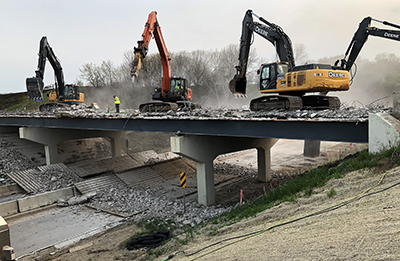
Demolition work occurs May 10 overnight to remove the Hwy 52 southbound bridge south of Zumbrota. Last year, the adjacent Hwy 52 northbound bridge was replaced. Photo by Scott Johnson |
Thanks to funding from the auto parts sales tax, District 6 has expanded a project on Hwy 52 from Zumbrota to Cannon Falls, originally scheduled for a mill and overlay, into a more comprehensive effort to address safety along a nearly 14-mile corridor.
The $69.7 million construction project comes after a design process that included more than two years of public engagement and outreach to connect with people who live, work and travel along Hwy 52. MnDOT’s team, led by project manager Jai Kalsy, held meetings in church gathering halls, city halls, fire stations, township halls and even at dining room tables, as they worked to develop a project that reflected the needs and concerns of the people affected by the work. MnDOT used these discussions to develop key elements of the projects, including the interchange at Hwy 57, snow drift control and safety improvements.
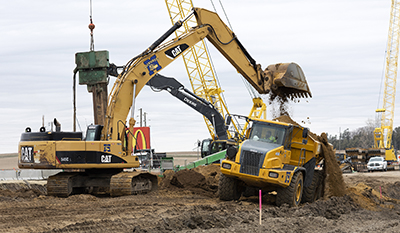
Construction crews prepare to build the Hwy 52 interchange at Hwy 57 and Goodhue County Road 8. Crews are building the northbound Hwy 52 bridge over Hwy 57 at the interchange first. Photo by Rich Kemp |
The construction project work began in July 2021 with crews replacing two bridges and building a series of median crossover lanes to aid moving traffic safely through the work zone in the coming years of construction work. Crews picked up where they left off last year and began work this year on April 21. If all goes according to plan, by November 2023, the completed work will include:
- Pavement reconstruction of 13.5 miles of southbound Hwy 52 (these lanes are the original roadbed that existed prior to its expansion to four lanes decades ago)
- Construction of an interchange and a new bridge at Hwy 57
- Replacement of four existing bridges and three box culverts
- Drainage improvements, including replacement of multiple drainage structures and lining of pipes
- Asphalt mill and overlay (three miles)
- Bridge overlay
- Closure of 27 access points and medians
- Grading of approximately four miles of local roadways.
- Noise Walls
- Snow fence
“The design-build project of Hwy 52 will improve safety along this busy road that connects the Twin Cities and Rochester,” said Tory Thompson, the MnDOT engineer and project manager for the project. “By the end of 2022, we’ll have seven miles of pavement reconstructed and an interchange built, and by fall of 2023, there will be seven more miles of pavement completed.”
Metro District has completed two projects in recent years on Hwy 52 and has another planned for 2023-2024. District 6 has another project further out and a study underway. To assist motorists and other who are interested in the Hwy 52 corridor, District 6 and Metro have teamed up to maintain a Hwy 52 corridor website for anyone interested in learning the latest information. |
|
By Doug Mack
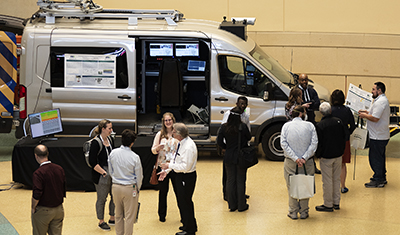
Visitors checked out the MnDOT Road Doctor survey van during the Transportation Conference & Expo. Photo by Rich Kemp |
For the first time since 2020, the Minnesota Transportation Conference & Expo returned to in-person sessions at the RiverCentre in downtown St. Paul. More than 1,400 people, including 400 MnDOT employees, attended the event, which ran from May 17 to May 19.
The return of the conference also included an increase in programming. “We added new improvements to try to make it more of a draw to increase attendance,” said Laurie Ryan, Engineering Services Division, who was one of the event’s organizers. “We expanded the number of track categories from seven topics last year to 13 tracks featuring 97 different sessions.”
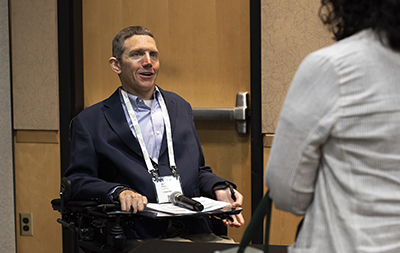
Chad Hanson, District 6 project manager, spoke with a participant after his presentation on ďManaging a Traffic Mess.Ē Photo by Rich Kemp |
Ryan worked with 13 MnDOT subject-matter experts who volunteered to serve as track chairs and selected the session topics from the more than 150 abstracts that were submitted. These experts included Andrew Andrusko, Nicki Bartelt, Michael Beer, Todd Bergland, Ken Buckeye, Paul Czech, Glenn Engstrom, Cindy Gross, Marni Karnowski, Chris Roy, Dave Solsrud, Tom Strybicki and Kevin Western. In addition to Ryan, the event’s planning committee over the last year included Beer, Engstrom, Melissa Brand and Mark Gieseke.
The expo portion of the event included 80 exhibitors, among them a MnDOT Road Doctor survey van. The van was a focal point, greeting visitors at the entrance to the expo hall and highlighting the agency’s use of the latest technology, including a 3D radar GPR unit—a large, yellow sensor mounted on the front of the van—and computer monitors showing data that MnDOT teams had collected using the vehicle. The expo hall also included a new Innovation Showcase Stage hosted by the Office of Materials & Road Research and two of its major partners, the National Road Research Alliance and the International Society for Intelligent Construction.
“We can thank our M&RR Office Director Glenn Engstrom as the driving force behind bringing these great partners with dozens of new attendees from across the country and beyond to our conference,” Ryan said.
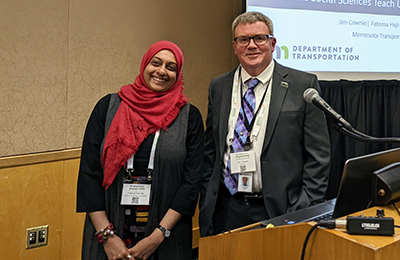
Deputy Chief Counsel Jim Cownie and Associate Legal Counsel Fatema Haji-Taki presented a session on ethical decision-making at the Minnesota Transportation Conference & Expo. Photo by Rich Kemp |
MnDOT employees led many of the sessions, with the far-ranging topics showcasing the breadth of the agency’s interests and efforts, from community engagement to civil engineering to best practices for business ethics.
At one session on Wednesday, Jay Hietpas, MnDOT’s Assistant Commissioner of Operations, led a presentation on connected and automated vehicles, discussing how this technology can improve safety and accessibility, while also noting some of the challenges of implementation. Hietpas highlighted the Med City Mover in Rochester, a MnDOT project featuring two low-speed, automated, electric, multi-passenger shuttles. During another Wednesday session, Mary Safgren, the planning director for District 4, collaborated with Michael Bowman of the White Earth Department of Transportation to discuss the topic of tribal partnerships in pedestrian planning.
Thursday’s MnDOT-led sessions included one on Rethinking I-94, offering a behind-the-scenes look at this ongoing project and the extensive public engagement involved, and a presentation on business ethics by Deputy Chief Counsel Jim Cownie and Associate Legal Counsel Fatema Haji-Taki. The latter session closed the conference but still had a full audience, which Cowrie called “very gratifying.”
“We hope that it helps to support having ethical considerations be part of our daily decision-making,” he said.
Looking back after the event, Haji-Taki said, “I had a great time at the conference learning new things, reconnecting in person with folks after such a long hiatus and establishing new relationships. As we move into a new phase of hybrid work, conferences such as these will become a vital part of building and maintaining relationships.”
Conference organizers hope for an even larger event in the coming years. “Our goal is to get it up to the 2,000 mark,” Ryan said, “and really build the Minnesota Transportation Conference & Expo into the regional industry event for the entire Midwest.”
|
 |
TABLE of CONTENTS
 |
New research aims to make freeway travel times more reliable |
By Doug Mack (adapted from MnDOT Technical Summary 2022-01TS)
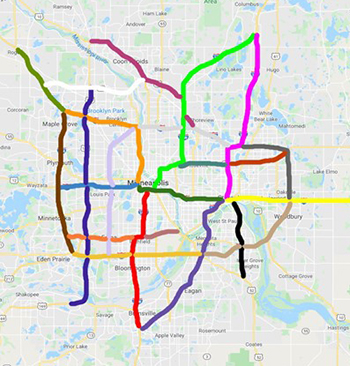
MnDOT and University of Minnesota investigators analyzed reliability measures in 23 corridors for two time periods representing morning and afternoon peak traffic periods. Image via Crossroads blog |
Providing consistent freeway travel times for Twin Cities area drivers requires careful traffic management and well-planned freeway projects. To effectively respond to incidents and identify the most needed renovations, MnDOT traffic managers need to know precisely where, when and why congestion is happening.
As part of MnDOT’s ongoing efforts to make travel times more reliable, the Office of Research & Innovation have partnered with researchers at the University of Minnesota Duluth to develop a software tool to help MnDOT effectively and efficiently identify congestion incidents. The software also supports the agency in identifying and prioritizing future freeway improvement projects.
In a previous MnDOT research project, investigators developed the Travel-Time Reliability Estimation System, which integrates data from multiple sources and estimates reliability measures for specific corridors under various operating conditions, such as weather, incidents and work zones. The tool proved useful in assessing the effectiveness of traffic control and incident management strategies during the 2018 Super Bowl in the Twin Cities.
Further enhancements were needed, however, to broaden its usefulness and create a comprehensive system that MnDOT traffic managers and planners can use to assess the reliability and traffic flow performance of the freeway corridors. MnDOT can also use the updated software for planning purposes, to develop optimal responses to various levels of traffic, weather and incident conditions and to prioritize corridor improvement strategies.
“These tools will help us identify not only the most problematic corridors for traffic congestion in the metro area, but the factors causing the problems. The data will be invaluable for our business and planning processes,” said Brian Kary, director, MnDOT Regional Transportation Management Center.
To develop the software, the researchers analyzed reliability measures in 23 corridors for two time periods representing morning and afternoon peak traffic periods. They also analyzed the travel-time reliability trends from 2016 to 2020 of 48 routes on 23 corridors, identified in collaboration with the Regional Transportation Management Center. The researchers used these results, along with other data, to create a “vulnerability index,” which indicates the combined level of reliability and congestion. This index can be used to rank individual corridors for needed improvements or other management treatments; it is also an essential tool for traffic managers and planners as they identify and prioritize bottleneck sections for each individual corridor in the Twin Cities freeway network.
To make the software more broadly accessible to traffic planners and managers, MnDOT will develop staff expertise and process protocols. And the work doesn’t end there—the research team from MnDOT and the University of Minnesota will continue to implement ongoing enhancements and improvements to the operation and maintenance of the software, and conduct further testing and refinement of the resilience model with additional research.
To read more about this research, visit the Crossroads, Minnesota’s transportation research blog. |
 |
|



